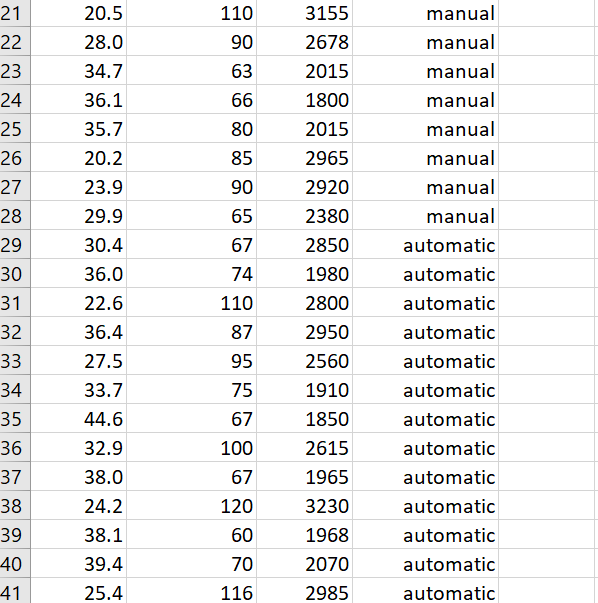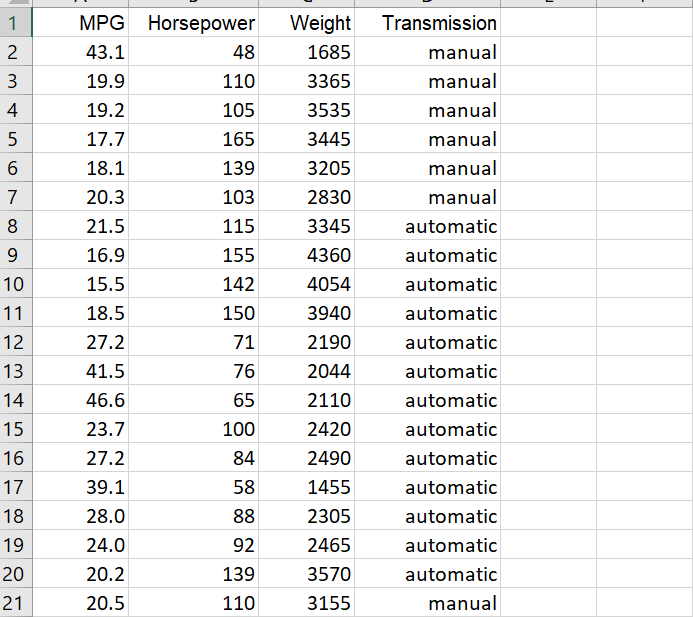Question
An analyst at a consumer organization must develop a regression model to predict fuel economy (also referred to as gasoline mileage) of automobiles measured in
An analyst at a consumer organization must develop a regression model to predict fuel economy (also referred to as gasoline mileage) of automobiles measured in miles per gallon (mpg) based on the horsepower of its engine, the weight of the car (in pounds) and the type of transmission (manual or automatic).The data for 50 randomly selected automobiles is presented in the table below.
1.Fit a multiple regression model for gasoline mileage as it depends on engine horsepower, vehicle weight, and the type of transmission (the "predictor" variables).
a.In a new line entered below this part, state the multiple regression equation, including your definitions of the variables.
b.In a new space entered below this part, insert a copy of the regression report.
c.In a new line entered below this part, explicitly define your coding of the "transmission" variable.
2.a.In new line entered below this part, state in words the specific meaning of the numerical value of the regression coefficient on engine horsepower in terms of what it measures for this problem. (In other words, what does this number measure and how much?)
b.In a new line entered below this part, state whether or not this coefficient makes sense according to what you would expect for it. Include a brief explanation for your response.
3.a.In a new line entered below this part, state in words the specific meaning of the numerical value of the regression coefficient on weight in terms of what it measures for this problem. (In other words, what does this number measure and how much?)
b.In a new line entered below this part, state whether or not this coefficient makes sense, according to what you would expect for it. Include a brief explanation for your response
4.a.In a new line entered below this part, state in words the specific meaning of the numerical value of the regression coefficient on transmission type in terms of what it measures for this problem. (In other words, what does this number measure and how much?)
b.In a new line entered below this part, state whether or not this coefficient has any practical meaning in the context of this problem. Include a brief explanation for your response.
5.a.In a new line entered below this part, state in words the specific meaning of the numerical value of the "Intercept" regression coefficient in terms of what it measures for this problem. (In other words, what does this number measure and how much?)
b.In a new line entered below this part, state whether or not this coefficient has any practical meaning in the context of this problem?Explain.
6.a.In a new line entered below this part, state the overall significance of this multiple regression. State the specific statistic or statistics that were used and how they were used. Finally, conclude whether or not this model is overall significant and state why.
b.In a new line entered below this part, state whether or not the coefficient on each individual predictor variable is significant. Explain your conclusion for each variable, including the specific statistic or statistics that were used and how they were used.
7.a.In a new line entered below this part, state the numerical value of the coefficient of determination for this model.
b.In new lines entered below this part, show that this coefficient is numerically equal to SSR/SST.
c.In a new line entered below this part, state the numerical value of the adjusted coefficient of determination for this model.
d.In a new line entered below this part, state what the adjusted coefficient of determination is adjusted for in the specific context of this problem,
e.In a new line entered below this part, state how much of the variation in mpg is fairly and truthfully represented by this model.
f.In a new line entered below this part, state how much of the variation in mpg is NOT fairly and truthfully represented by this model.
8.a.In a space created below this part, insert a copy of the plot of the residuals of this model against its fitted values.
b.In a new line entered below this part, describe the appearance of this residual plot.
c.In a new line entered below this part, state the RMSE of this regression.
9.a.In a new line entered below this part, state the gasoline mileage (in mpg) predicted for a vehicle that has a 105-horsepower engine, weighs 3380 pounds, and has a manual transmission.
b.In a new line entered below this part, state the numerical value of the residual in gasoline mileage between the mpg calculated in part 9.a and the actual gasoline mileage for this vehicle as listed in the data table.
c.In a new line entered below this part, state two reasons why the result calculated in part 9.a is different from the actual gasoline mileage for this vehicle as listed in the data table.
10.a.In a new line entered below this part, state the gasoline mileage (in mpg) predicted for a vehicle that has a 135-horsepower engine, weighs 2650 pounds, and has an automatic transmission.
b.In a new line entered below this part, state a 95% prediction interval for your prediction in part 10.a.



Step by Step Solution
There are 3 Steps involved in it
Step: 1

Get Instant Access to Expert-Tailored Solutions
See step-by-step solutions with expert insights and AI powered tools for academic success
Step: 2

Step: 3

Ace Your Homework with AI
Get the answers you need in no time with our AI-driven, step-by-step assistance
Get Started


